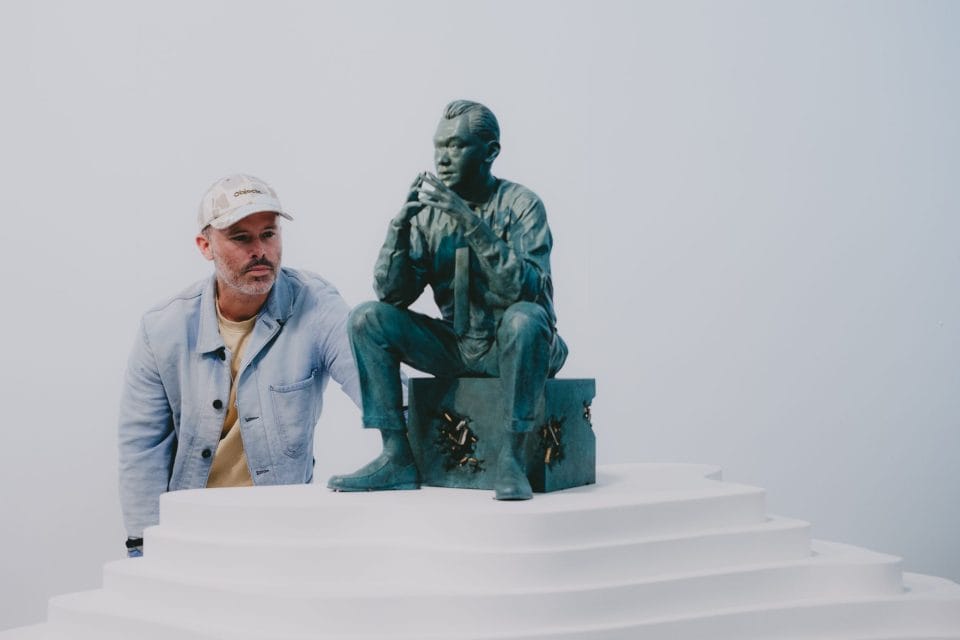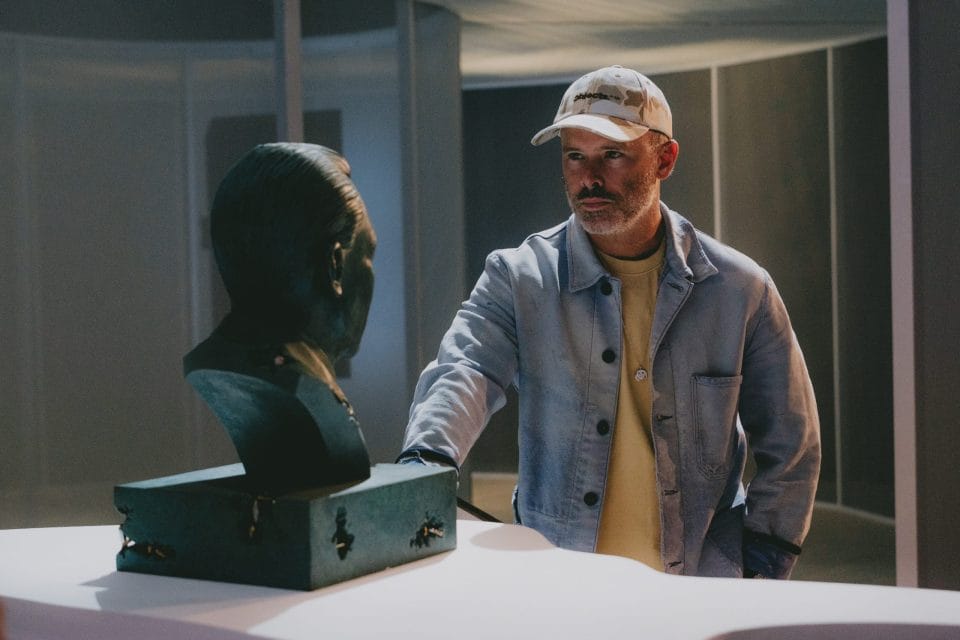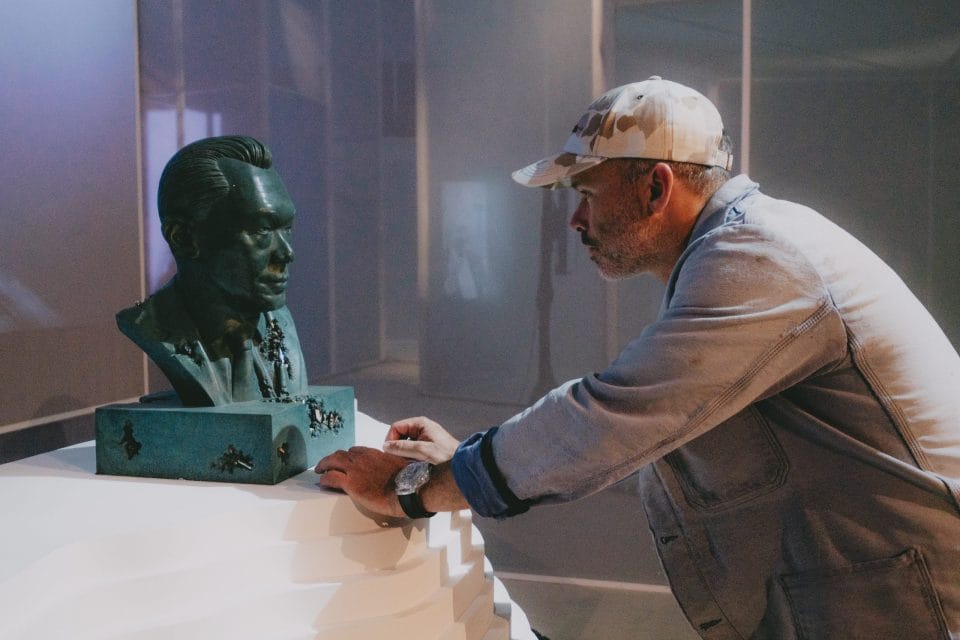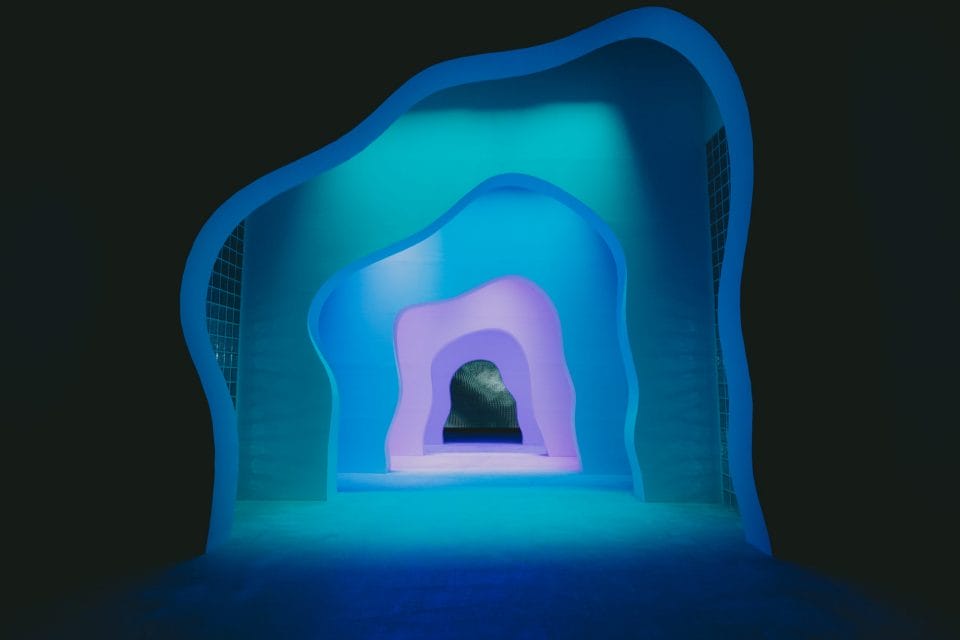
In town to officiate the opening of the exhibition Now Is Not The Time — a first-of-its-kind modern immersive art installation that marks the 100th anniversary of the birth of Singapore’s Founding Father Lee Kuan Yew — is contemporary creative Daniel Arsham. We took this opportunity to sit down for a chat with him, discussing how this opportunity came to fruition, his thoughts on AI in art, and advice he would like to give to young, aspiring creatives today.
What does art mean to you, and why?
I think art is a way of sort of exposing things that are just below the surface of our everyday reality. Things that we may not pay attention to, or can be revealed in in new ways. And the artists job is to basically scratch the surface and reveal those things.
What inspires you to create?
Since I was a kid, I was always drawing and taking photos. It was a way to sort of look at the world through my own lens. Much of my work over the last 20 years has also been inspired through travel and being in different countries, meeting different people and engaging with people in other disciplines of architecture, music, film and other areas of creative output.
View this post on Instagram
Time is always a big element that you often mention concerning inspirations in past interviews. What about it makes a good source material to play with?
So much of our everyday experience is governed by the way that we package time. We have schedules for the day, but we also think about weeks and months and, and we’re constantly trying to orient ourselves around our relationship with time. And so a lot of my work has been able to, or has attempted to allow us to escape that idea and sort of be a little bit confused about where we are in time.
I made a very large series of works that was done in collaboration with the Louvre Museum in Paris. They depicted works from antiquity, mixed with contemporary objects or characters like Pokemon. So you have ancient Greek busts next to Pikachu, and they’re made of the same material. They look like they’re eroding, but they’re made of crystals. So there’s a lot of confusion in the works about when they could have been made. And I think part of the intention is to allow us to be set into a different time scenario.
Your works often meld the past, the present, and the future. Which of these three speaks most to you and your art?
It’s relatively easy for us to look into the past and say, Okay, we know certainly what we experienced in our own lifetime. We can look back 100 years, maybe 2000 years, and we will still have a pretty concrete idea about what that felt like. Going forward into the future. I think we can imagine maybe what it’s going to be like in a year from now, or 10 years from now. But the further you get, like 100 years from now, or 500 years from now, it’s very difficult to project what that is. I think the difference between the future and the past is sort of where my interest lies in my work.
View this post on Instagram
And how is the interpretation of time evolved over the years?
I think the integration of, or the collaboration with these different works from history, the work from the Louvre and collaborating with creators like Pokemon Company, allowed me to think about what the icons of today are. If I’m imagining them as an archaeological relic in the future. The way that we often understand history is through objects. And I don’t know if that really answered the question, but sort of gets to the heart of what I’m trying to do with my own work.
You have collaborated with a roster of remarkable name brands that cut across a wide breadth of the creative industry. Why?
The process by which I’ve made things comes about over years of study, and they feel quite natural to me. I know how to draw very well, as an example. Many of those things that I create feel magical to other people, because it’s difficult for them to understand how they were made. So part of the reason for me to look at other creators, people in music, other artists, architects, musicians, is to be a witness of and a part of their magic. It’s why I think so many of my friends are in other industries. I’ve tried to be in their magic.
 How did this collaboration happen for you? Why did you take it on?
How did this collaboration happen for you? Why did you take it on?
I mean, there’s two interesting things about it. One, Singapore was one of the first places that I ever visited in Asia over 10 years ago now. It was a pivotal moment in my career. I had an exhibition here, I was a visiting instructor at one of the art colleges, and it always felt like a place that was very future-looking, a very futuristic city. Then this opportunity came to me, and it was certainly within my work. I haven’t done portraiture much, typically making works that are based on historical objects that existed thousands of years ago, or of contemporary figures like Pharrell and Steve McQueen. Lee Kuan Yew is a significant cultural figure in both Singapore and internationally, so to recognise this moment, his 100th birthday, and to try to find a way to do it is something meaningful for me.
Part of me joining this exhibition is because a lot of my audience is the younger audience. And so this is a way to introduce them to this universe, of their of their own culture.
After all this research you have done for this exhibition, what is it about Mr. Lee that stood out for you the most?
You know, there’s not a lot of countries that are this young and have managed to achieve this much in such a short period of time. He was obviously very deliberate and diligent about how he wanted the society to be structured, and he’s also a very open person in terms of embracing cross-cultural influence; the multicultural agenda here makes a very sort of future-looking society. I think all of us kind of want to be part of a society like this.
But then there’s also something that often happens with historical figures, when they become an icon to the point where you can’t really imagine them as real-life people. In the emotion of that moment for him, maybe how nervous he was, how much pressure was on him in that time to step up and lead this new nation, that’s what I wanted to explore. It feels like a given now, but there was no guarantee that Singapore will be its own country. And I think, you know, it was directly through his doing just that.
 Do you think your art was able to honour Singapore’s founding father in the way you wanted it to?
Do you think your art was able to honour Singapore’s founding father in the way you wanted it to?
It’s quite a challenge to depict somebody who’s the founder of a country and everyone from that country is going to see that work. He is also not alive today, so only knowing him through anecdotes, images, and the finer details of how clothing wears on his body was quite a challenge. The way that his profile looks in all of that was something I wanted to keep, the power stance he had. But I think in the end, I think it worked.
Let’s focus on the eroded LKY full body sculpture. What is an insight into your creation that will help the readers appreciate the work even more?
I talked a little bit before about how artists are alchemists in a way, take one material and turning it into something else. The process for creating these bronze works would traditionally involve sculpting entirely in clay or some other object, then creating a mould of that and casting it in wax before belting it out. For the last five or six years, I’ve started to implement or integrate digital, three-dimensional sculpting in the studio to allows a much more accurate portrayal of what I envisioned. When I worked with Pokemon, it was the same thing, but there’s still a hand and touch to the works.
Another element of these works that is present in much of bronze work is this dark green patina. The intention here was to create a sense of age, that the work is old has been here for quite a long time. Maybe like the 100 years of his life.
 Your art is often described as a reflection on the passage of time, highlighting the impermanence of objects. How is this quality captured in the works for the exhibition from the past, to the eroded LKY?
Your art is often described as a reflection on the passage of time, highlighting the impermanence of objects. How is this quality captured in the works for the exhibition from the past, to the eroded LKY?
The use of crystal in my works has two functions. One is the visual quality of what it’s going to look like in the end. And the other is what the material of it is going to tell us about the the object. These works for LKY are made in bronze, which is a very traditional art-making material. So it allows the work to fit into this kind of lineage of art history and that sort of canon. In much of my work, I’m using the idea of the crystal to similarly associate the semblance of a long timeframe, something that could last or develop or grow over thousands of years. So the material of the objects are chosen to tell a story about what the thing is, as much as supply this specific visual quality to complement the narrative.
How did the use of AI influence your work in general?
I wasn’t directly involved in with the video, but I have used AI. Just not in this work particularly. As every new technology comes out, it’s another tool for artists to implement in their own work. I’ve asked AI to imagine other variations of my work by feeding it previous works of mine, either paintings or sculpture, and it made some very strange things that I wouldn’t necessarily have thought of. I guess this can form as inspiration for new works.
 Could you tell me more about your first encounter with Singapore?
Could you tell me more about your first encounter with Singapore?
I had done a project with Louis Vuitton before and it’s actually drawings for a book. And I don’t know why they chose to release it here. But they chose Singapore as the place to do the exhibition, so I ended up here. I think it was 2013.
Has your impression of the place changed since then?
I mean, I’ve been to a lot of places since then. So it feels maybe more familiar to me. We’ve also been back here probably five times for this. You get off the plane, you feel the humidity; I grew up in Miami so I’m familiar with that. Something about the architecture here and the vines on the big rainforest trees, it feels somewhat like a familiar face to me.
Now, I also have many friends to come back to.
View this post on Instagram
Speaking of architecture, it’s an element that stands out in your art and your work in general. Your work cuts across so many different disciplines in art, but I feel like the aspect of structure and form is so unique for your work. Why do you like to express it in such a visceral manner?
I mean, architecture has always been interesting to me, I think it’s like a sculpture that you can walk into and it houses you. The way that lighting and temperature and scent and all those things, materials, wastes and sounds, all those things give you the potential to feel about things. So I often use architecture in exhibitions as a way to kind of enhance your experience about my works.
I think this “magic” of artists is a wonderful way of wording the moments when artists shine the brightest. Has there been a magical moment of this sorts lately? Perhaps in any recent collaborations?
I think for me, because I don’t have anything to do with making music, anytime that I’ve been in the studio with other musicians, watching them work, makes me feel the magic most immediately and viscerally.
View this post on Instagram
Would you ever want to like work with sound yourself? Or like the future?
I’ve used it in exhibitions and different kinds of shows, but more like an atmospheric kind of feeling. So rhythmic is just ambient.
Then what new challenges or interesting project that you want to like, take up like a dream project. What would that be?
I have a separate practice also architecture and we’ve been working a lot more recently in hospitality and restaurants, hotels, things like that, where I think a lot of people, especially myself included, when we travel, it’s where we are inspired with new ways of thinking about space. And when we stay in a hotel. It’s often so different from our own homes. And so this is an area I’d love to be involved with. But you know, I’m still in the studio every day painting and drawing and sculpting.
View this post on Instagram
A lot of the young people now consider themselves, creators and you don’t even have to go to like art school to be a creative. So as someone who has done so many creative things, and like in your career, and maybe first off as well. What’s one piece of advice that you would give to the people who want to make a path for themselves to like, express their art and their personality?
I think patience is really important. I love the youth and their energy and their enthusiasm. I think that there, there’s a little bit of sense of wanting to arrive at a successful something very quickly. And, you know, I’ve been working at this for 20 years now. And maybe even after 10 years to 10 years ago, when I came to Singapore. I was known a little bit, but not that well known. And it takes a very long time, and a lot of disappointment and failure to arrive at a place of success.
So do you feel like you’re at that point right now, or you’re like, not enough, there’s more.
There’s always more to do. I definitely arrived at a point where I have a different level of confidence in my work. And it’s easier for me to make decisions about things in relation to my work. I trust my instinct more.
View this post on Instagram
So would you say you understand yourself more?
Yeah, I mean, I understand myself. Specifically in relation to my work. As a younger artist you often question if what you are doing is right. Whether the gesture that I’m making is interesting or whether the work does what I want it to do. And there’s an instinct that you get over time about making. I think I’ve always trusted that instinct but I’ve come to the point now where it’s like immediate and I really like when I see something that I’ve made and I know that it’s gonna be a thing that works, and it’s going to do what I intend it to do.
Once you’re done with this story, click here to catch up with our September 2023 issue!







